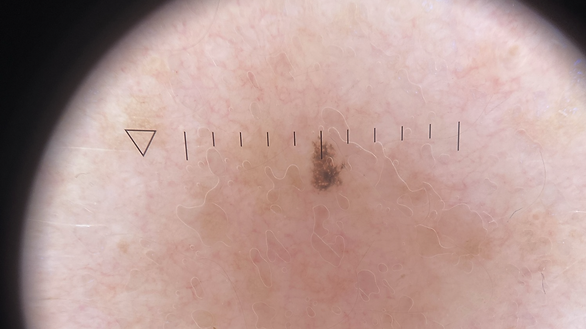Ink Spot Lentigo
Author: Emily Wales
Chief Editor: Dr Daniel Keith
Macroscopic Appearance

Ink spot lentigo, also known as "reticulated black solar lentigo" is a melanotic macula. It is characterised by a very dark colour and a beaded/wirey irregular outline with well-demarcated edges under dermoscopy. It is a variant of solar lentigo and is a benign lesion.
Ink Spot Lentigo affects males and females of all ages, however, is more prevalent in fair-skinned adults (Fitzpatrick's skin phototype I and II). It is commonly found in sun-exposed area of skin, most commonly on the trunk and they typically appear after an episode of sunburn. Ink Spot Lentigos eventually become ordinary solar lentigenes with age.
Ink Spot Lentigo: the central, three pronged lesion in the centre of this image
Dermoscopic Appearance
Because of its dark appearance, it can be mistaken for a melanoma. To differentiate the two a skin biopsy may be required. However, dermoscopy can help to try and differentiate the two apart. An ink spot lentigo is typically; symmetrical, macular, smaller, and stable in size as compared to a melanoma.
Features include:
-
Melanocytes mainly around the rete ridges (hyperpigmentation tips of the rete ridges)
-
Areas lacking pigment involve the suprapapillary epidermis ridges.
-
Typically <5mm in size
-
Solitary
-
Very well demarcated under dermoscopy
-
The edges stop abruptly which makes them look superficial - hence the ‘ink’ name

Zoomed-out image of Ink Spot Lentigo

Dermoscopic appearance of a single Ink Spot Lentigo
The images below (courtesy of Dr. Justine De Mink, GP) show further dermoscopic examples of Ink Spot Lentigos. The images highlight the areas which lack pigmentation and the monomorphic network (network looks the same throughout the lesion) which are both characteristics of Ink Spot Lentigos.


